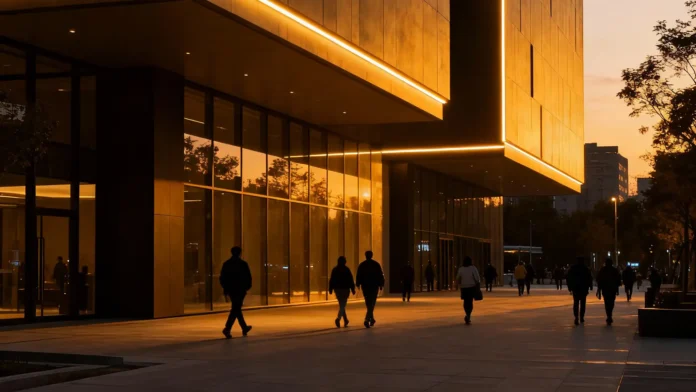Balancing Aesthetics and Functionality in Façade and Outdoor Lighting
The intersection of aesthetic vision and functional performance in exterior lighting design represents one of the most complex challenges in contemporary architecture. Façade lighting design aesthetics functionality considerations must address multiple competing demands including architectural expression, energy efficiency, maintenance requirements, light pollution concerns, and community integration while creating installations that enhance both building identity and urban character.
Architectural Expression Through Illuminated Form
Façade lighting serves as a powerful tool for architectural expression that transforms buildings into dynamic elements within urban landscapes. The strategic application of lighting techniques can enhance architectural features, create visual hierarchy, and establish distinctive building identities that contribute positively to cityscape character both day and night.
Contemporary façade lighting approaches have evolved beyond simple floodlighting techniques to encompass sophisticated systems that respond to architectural geometries while creating layered lighting effects that reveal different aspects of building design throughout evening hours. These installations consider how light interacts with building materials, textures, and forms to create compelling visual experiences.
The integration of lighting elements within architectural details allows designers to create seamless installations where illumination appears to emerge naturally from building surfaces rather than being imposed by external lighting equipment. This approach requires close collaboration between architects and lighting designers from early design phases to ensure successful integration of lighting systems with architectural elements.
Functional Performance Requirements
Exterior lighting systems must satisfy numerous functional requirements including pedestrian safety, vehicle navigation, security illumination, and wayfinding support while maintaining appropriate illumination levels throughout various seasons and weather conditions. These functional demands often conflict with aesthetic objectives, requiring careful design balance.
Security lighting requirements for building perimeters must provide adequate illumination for surveillance systems while avoiding harsh lighting conditions that compromise architectural aesthetics or create uncomfortable environments for legitimate users. Modern LED technologies and sophisticated control systems enable more nuanced approaches that satisfy security needs without sacrificing design quality.
Seasonal performance variations significantly impact exterior lighting system effectiveness, with winter conditions often requiring different lighting strategies than summer installations. Successful façade lighting design aesthetics functionality approaches account for these variations through flexible systems that maintain performance throughout annual cycles.
Energy Efficiency and Environmental Responsibility
Contemporary façade lighting projects face increasing pressure to demonstrate environmental responsibility through energy-efficient technologies and operational strategies that minimize environmental impact while maintaining desired aesthetic and functional performance levels. LED technology has fundamentally transformed exterior lighting possibilities while reducing energy consumption requirements.
Intelligent control systems enable façade lighting installations to optimize energy consumption through automated scheduling, occupancy detection, and daylight harvesting while maintaining security and aesthetic functions when needed. These systems support both environmental goals and operational cost management while providing flexibility for special events and seasonal celebrations.
Solar integration and renewable energy sourcing for façade lighting systems represent emerging opportunities to further reduce environmental impact while demonstrating commitment to sustainability goals. These approaches require careful system sizing and battery management but can provide truly sustainable lighting solutions for appropriate applications.
Light Pollution Mitigation and Community Integration
Responsible façade lighting design must address light pollution concerns that affect astronomical observation, wildlife behavior, and community quality of life while maintaining desired architectural and functional objectives. Modern lighting technologies and design techniques enable dramatic lighting effects with minimal environmental impact when properly applied.
Dark sky compliance requirements vary significantly between different locations and may impose strict limitations on exterior lighting systems that affect both aesthetic possibilities and functional performance. Understanding local regulations and community expectations helps designers develop appropriate solutions that satisfy multiple stakeholder interests.
The temporal aspects of façade lighting operation significantly impact community acceptance, with late-night operation often creating conflicts between aesthetic objectives and residential tranquility. Automated control systems can address these concerns through time-based dimming and operational scheduling that balances architectural expression with community courtesy.
Material Integration and Weather Resistance
The selection of lighting equipment for exterior applications must consider harsh environmental conditions including temperature extremes, moisture exposure, UV radiation, and physical abuse while maintaining consistent performance and appearance throughout extended service life. Material compatibility between lighting equipment and architectural finishes affects both system longevity and aesthetic integration.
Concealed installation techniques protect lighting equipment from environmental exposure while maintaining clean architectural appearances that don’t compromise building design integrity. These approaches often require more complex installation procedures but result in more durable and aesthetically pleasing installations that age gracefully.
Maintenance accessibility represents a critical consideration for façade lighting installations that may be difficult or expensive to service after installation. Design approaches that facilitate routine maintenance while maintaining security and aesthetic requirements help ensure that systems continue to perform effectively throughout their intended service life.
Control Systems and Programming Flexibility
Modern façade lighting systems require sophisticated control capabilities that can manage complex lighting scenarios while remaining accessible to building operators who may have limited lighting expertise. These systems must balance advanced functionality with operational simplicity to ensure that intended lighting effects are actually achieved in practice.
Scene programming capabilities enable façade lighting systems to create different lighting effects for various occasions while maintaining base-level illumination for security and functional requirements. These capabilities support both routine operation and special event lighting without requiring specialized expertise for each operational change.
Integration with building automation systems enables façade lighting to respond to occupancy patterns, security conditions, and environmental factors while maintaining appropriate lighting levels and effects. These integrated approaches optimize both performance and energy consumption while reducing operational complexity.
Urban Context and Cityscape Contribution
Successful façade lighting design must consider broader urban context including neighboring buildings, streetscape character, and community lighting standards that affect how individual lighting installations contribute to overall cityscape quality. The cumulative effect of multiple façade lighting projects significantly impacts urban nighttime character and quality.
Historic district considerations may impose restrictions on façade lighting approaches while creating opportunities to enhance architectural heritage through carefully designed lighting installations that reveal architectural details and building character without compromising historical authenticity. These projects require particularly sensitive design approaches that balance preservation goals with contemporary lighting capabilities.
Wayfinding and urban navigation support through façade lighting contributes to broader urban functionality while enhancing individual building identity. Strategic use of lighting intensity, color, and pattern can help create legible urban environments that support both vehicular and pedestrian navigation needs.
Technology Integration and Future Adaptability
The rapid evolution of lighting technologies creates both opportunities and challenges for façade lighting installations that must remain current and effective throughout extended service lives. Future-proofing strategies help ensure that lighting investments continue to provide value even as technologies and aesthetic preferences evolve.
Color-changing capabilities and dynamic lighting effects have become increasingly accessible through LED technologies, enabling façade lighting installations to adapt to changing needs and occasions while maintaining base-level functional illumination. These capabilities must be balanced against complexity and maintenance considerations that affect long-term system reliability.
Smart city integration opportunities enable façade lighting systems to participate in broader urban systems including traffic management, emergency response, and public communication while maintaining their primary architectural and functional objectives. These integrated approaches require careful consideration of privacy, security, and operational implications.
Economic Considerations and Lifecycle Cost Management
The total cost of ownership for façade lighting systems extends far beyond initial installation costs to encompass energy consumption, maintenance requirements, equipment replacement, and operational management throughout system lifecycle. Understanding these broader cost implications helps justify investment in higher-quality systems that provide superior long-term value.
Financing options including energy service company (ESCO) arrangements and power purchase agreements can help address initial cost barriers while ensuring professional system design and maintenance throughout operational life. These approaches often result in superior system performance and reliability compared to lowest-bid installations.
Return on investment calculations for façade lighting must consider both quantifiable benefits such as energy savings and qualitative improvements such as enhanced property value, tenant satisfaction, and community contribution. Comprehensive economic analysis supports more informed decision-making while justifying investment in high-quality design and installation.
Design Process Integration and Professional Collaboration
Successful façade lighting design requires close collaboration between architects, lighting designers, electrical engineers, and specialty contractors from early design phases through project completion and beyond. This integrated approach helps ensure that aesthetic vision, functional requirements, and technical constraints are all addressed effectively.
Mock-up installations and photometric testing help verify design performance while providing opportunities to refine installation techniques and system programming before full-scale implementation. These validation procedures are particularly important for façade lighting projects where performance verification after installation completion may be difficult or impossible.
Post-occupancy evaluation and performance optimization help ensure that façade lighting installations continue to meet intended objectives while identifying opportunities for improvement that can inform future projects. This feedback loop supports continuous improvement in design approaches and technical implementation while building professional knowledge and expertise.
The successful balance of façade lighting design aesthetics functionality requires comprehensive understanding of architectural objectives, technical constraints, environmental responsibilities, and community expectations. The most successful projects are those that achieve compelling aesthetic results while addressing all functional requirements through thoughtful design integration and professional collaboration throughout all project phases.































